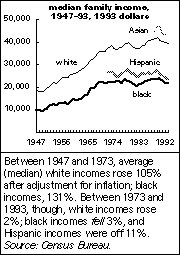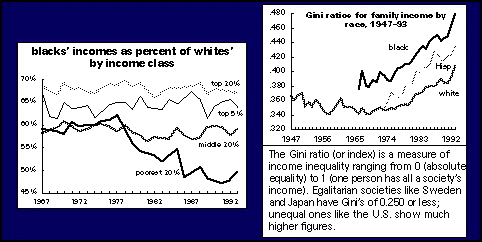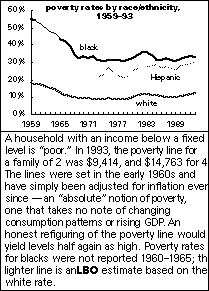
Home Mail Articles Stats/current Supplements Subscriptions Links
The following article appeared in Left Business Observer #69, September 1995. It was written by Doug Henwood, editor and publisher. It retains its copyright and may not be reprinted or redistributed in any form - print, electronic, facsimile, anything - without the permission of LBO.
Several issues ago, LBO reported that women's incomes are gaining on men's, though we're still a long way from equality. We promised a similar look at race and material welfare. Here the news isn't so good.
Average incomes of all families of all colors have stayed remarkably
flat over the last 20 years. (Family, rather than household which
includes individuals living alone or in arrangements not recognized
as familial by the authorities is used because it goes back to
1947, while household coverage begins 20 years later. Non-family
households have lower incomes than family ones.) White incomes
have risen a bit, on average, while incomes for black and Hispanic
families have declined (see chart). Asian-Americans have the highest
incomes of any ethnic group, but the Census Bureau has only reported their incomes
since 1987. 
A note on coverage and nomenclature. This piece will focus mainly on African-Americans, despite the fact that race in America is no longer a matter of black and white. There are several reasons for this. First, figures on African-Americans go back much further than any other group; coverage of Asian-Americans and Native Americans is spotty. Second, despite all the changes of recent decades, blackwhite relations remain one of the central melodramas of American life.
And third, it's risky to generalize about the Hispanic population. Even the name itself is controversial; LBO uses it because the Census Bureau does. But many people so labelled don't like it, and the population it's applied to is diverse in origin, residence, and status. "Hispanic," as statisticians always point out, is unrelated to race. In the Census Bureau's yearly income reports, the source of most of the data in this article, about 90% of Hispanics call themselves white. Since Hispanics have lower incomes on average than non-Hispanic whites, including them under "white" category de presses average white incomes and boosts white poverty rates. The Census Bureau does report some data for non-Hispanic whites, but if people consider themselves "white," who's to second-guess them? Unless otherwise noted, all figures for whites on this page include those Hispanics who consider themselves such.
Many stories can be hidden behind averages, which is the point of the chart that looks at the richest, middle, and poorest fifth of black households relative to their white counterparts. Rich and middle -class black households have largely held their own against their white counterparts, which means they're still behind, but haven't fallen any further so but the black poor have done miserably. While the share of the black population living in officially defined poverty has stayed rather steady since the late 1960s, their average incomes have been eroding badly.

Consequently, the chart of the Gini index shows that inequality
is greater among blacks than others, and is getting more so at
a faster pace. The picture for Hispanics is much less dramatic;
their inequality, as measured by the Gini, falls between black
and white levels. A chart for Hispanic income groups like the
one shown here for black incomes would show all the income groupings
clustering around 7075% of the income of their white counterparts,
with less stratification than among African-Americans. Incomes
of the poorest Hispanics fell sharply relative to whites from
the early 1970s through the mid-1980s, as new immigrants from
Mexico, Central America, and the Dominican Republic joined the
more prosperous Cubans and Puerto Ricans already here. 
One shouldn't conclude from this, however, that all is prosperous among the white population. Since non-Hispanic whites are so much more numerous than "minorities," despite their lower poverty rate, they make up almost half (48%) of the poor. The absolute number of very poor whites (incomes below half the poverty line)is well above the black indigent. Even the clichéd figure of American utopia, the suburban married couple family (of any race) with children under age 6 faced a one in ten chance of being poor in 1993, a high risk for a socially idealized form of life; another clichéd group, white married-couple families with young children (regardless of residence), faced a one-in-five chance of being poor. This is not to argue that being white doesn't have its privileges; the point is that the U.S. generates lots of poverty, even among putatively well-off groups.
Since most people between the ages of 18 and 64 depend on work for almost all their income, the forces underlying dispersion in incomes are mainly those of the labor market. Work by Jared Bernstein for the Economic Policy Institute (Where's the Payoff?, April 1995) sheds great light here. While it's well-known that real average hourly wages have been falling for twenty years, it's less well known that women's earnings have risen while men's have fallen (see table). An important reason for women's rising average incomes, though, was their invasion of male-dominated profes sions; when women's pay in comparable job categories is compared to men's, their progress looks much less impressive.

Black men in every educational grouping earned a lower real hourly wage in 1993 than 1979, reversing the progress of the 1970s. Better-educated white guys did well until the Bush slump, but now even they aren't spared downward mobility. White men who didn't make it through high school have gotten hammered.
Of course, white dropouts still made a bit more than their black counterparts, despite their worse relative performance; in most categories, blacks did worse than whites. A catalog of white losses should never overshadow the vast gaps between blacks and whites at all educational levels 1020% within the same class. White privilege, especially for men, now means that one's wages are probably falling more slowly than those of nonwhites.
Middle class married-couple households sustained their incomes only because more married women were working at better jobs and for higher pay. But that sort of household is hardly the norm it's thought to be. Among whites, 73% of all households were married couples in 1970, 53% of blacks were, and 87% of Hispanics. By 1993, the share for all had fallen dramatically to 58% for whites, 34% for blacks, and 55% for Hispanics. The female-headed household, so bemoaned by Clinton, Gingrich, and Charles Murray, has grown in a mirror image to 10% of white households in 1993, almost 33% of blacks, and 19% of Hispanics. Also, almost 30% of all whites and blacks, and 20% of Hispanics, now live in nonfamily households (alone, or with friends, lovers, or room mates).

The growth in nontraditional households is often blamed for the
economic troubles of nonwhites. This deserves rejection on principle
alone: living arrangements should be a matter of affection and
choice, not mean necessity. But principle doesn't cut much ice
with the Trad Vals crowd; one can make the more technocratic point
that many black men have had a pretty awful time of it in the
labor market since the 1970s, as Bernstein's numbers show, making
marriage less materially tenable than it once was.
Liberals, when they pause from moralizing about single motherhood, blame a lot of the racial money gap on an educational gap. Bernstein's report proves this wrong. While there was once a large gap between white and black high school completion rates, it has now almost disappeared, and the gap in reading and math proficiency scores has narrowed lots. There is still a gap between white and black college attendance mainly because of reduced financial support but since well under half of today's young whites even enter college, and only one in five adults has a college degree, that dispar ity doesn't affect most workers. Were incomes as closely tied to education as we're told, black incomes should have gained on whites, but they haven't.
Why not? Blacks have been disproportionally hurt by deindustrialization; those who lost factory jobs have either stayed unemployed longer than whites, or gotten crummier replacement jobs in the service sector. One can summon all sorts of fancy reasons for this economists use phrases like "a disadvantaged position in the hiring queue" but they boil down to discrimination. The plunge in the real value of the minimum wage and the decline of unions have also hurt two more reasons not unrelated to discrimination, since institutions like these protect people subject to bigotry. Despite the line fashionable in right-wing circles, minimum wages are not primarily earned by the teenage offspring of affluent whites; and despite the line fashionable in chic postmodern circles, unions are not mere bastions of white male privilege. Blacks are more likely to earn the minimum wage or something close to it, and are more likely to be union members than whites .
White guys haven't done too well, at least in dollar terms, over the last 20 years. It's hard to see, though, how these losses can be traced to minorities' gains, as is argued by fevered white imaginations.
Home Mail Articles Stats/current Supplements Subscriptions Links